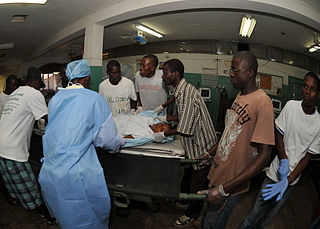Related Research Articles
Occupational therapists (OTs) are health care professionals specializing in occupational therapy and occupational science. OTs and occupational therapy assistants (OTAs) use scientific bases and a holistic perspective to promote a person's ability to fulfill their daily routines and roles. OTs have immense training in the physical, psychological, and social aspects of human functioning deriving from an education grounded in anatomical and physiological concepts, and psychological perspectives. They enable individuals across the lifespan by optimizing their abilities to perform activities that are meaningful to them ("occupations"). Human occupations include activities of daily living, work/vocation, play, education, leisure, rest and sleep, and social participation.
A health system, health care system or healthcare system is an organization of people, institutions, and resources that delivers health care services to meet the health needs of target populations.
Health, according to the World Health Organization, is "a state of complete physical, mental and social well-being and not merely the absence of disease and infirmity". A variety of definitions have been used for different purposes over time. Health can be promoted by encouraging healthful activities, such as regular physical exercise and adequate sleep, and by reducing or avoiding unhealthful activities or situations, such as smoking or excessive stress. Some factors affecting health are due to individual choices, such as whether to engage in a high-risk behavior, while others are due to structural causes, such as whether the society is arranged in a way that makes it easier or harder for people to get necessary healthcare services. Still, other factors are beyond both individual and group choices, such as genetic disorders.

Health care, or healthcare, is the improvement of health via the prevention, diagnosis, treatment, amelioration or cure of disease, illness, injury, and other physical and mental impairments in people. Health care is delivered by health professionals and allied health fields. Medicine, dentistry, pharmacy, midwifery, nursing, optometry, audiology, psychology, occupational therapy, physical therapy, athletic training, and other health professions all constitute health care. It includes work done in providing primary care, secondary care, and tertiary care, as well as in public health.
A need is dissatisfaction at a point of time and in a given context. Needs are distinguished from wants. In the case of a need, a deficiency causes a clear adverse outcome: a dysfunction or death. In other words, a need is something required for a safe, stable and healthy life while a want is a desire, wish or aspiration. When needs or wants are backed by purchasing power, they have the potential to become economic demands.

Suicide prevention is a collection of efforts to reduce the risk of suicide. Suicide is often preventable, and the efforts to prevent it may occur at the individual, relationship, community, and society level. Suicide is a serious public health problem that can have long-lasting effects on individuals, families, and communities. Preventing suicide requires strategies at all levels of society. This includes prevention and protective strategies for individuals, families, and communities. Suicide can be prevented by learning the warning signs, promoting prevention and resilience, and committing to social change.

Halfdan Theodor Mahler was a Danish physician. He served three terms as Director-General of the World Health Organization (WHO) from 1973 to 1988, and is widely known for his effort to combat tuberculosis and his role in having shaped the landmark Alma Ata Declaration that defined the Health for All by the Year 2000 strategy.

Primary health care, or PHC, refers to "essential health care" that is based on scientifically sound and socially acceptable methods and technology. This makes universal health care accessible to all individuals and families in a community. PHC initiatives allow for the full participation of community members in implementation and decision making. Services are provided at a cost that the community and the country can afford at every stage of their development in the spirit of self-reliance and self-determination. In other words, PHC is an approach to health beyond the traditional health care system that focuses on health equity-producing social policy. PHC includes all areas that play a role in health, such as access to health services, environment and lifestyle. Thus, primary healthcare and public health measures, taken together, may be considered as the cornerstones of universal health systems. The World Health Organization, or WHO, elaborates on the goals of PHC as defined by three major categories, "empowering people and communities, multisectoral policy and action; and primary care and essential public health functions as the core of integrated health services[1]." Based on these definitions, PHC can not only help an individual after being diagnosed with a disease or disorder, but actively prevent such issues by understanding the individual as a whole.

The right to health is the economic, social, and cultural right to a universal minimum standard of health to which all individuals are entitled. The concept of a right to health has been enumerated in international agreements which include the Universal Declaration of Human Rights, International Covenant on Economic, Social and Cultural Rights, and the Convention on the Rights of Persons with Disabilities. There is debate on the interpretation and application of the right to health due to considerations such as how health is defined, what minimum entitlements are encompassed in a right to health, and which institutions are responsible for ensuring a right to health.
Declaration of Alma-Ata was adopted at the International Conference on Primary Health Care (PHC), Almaty, Kazakh Soviet Socialist Republic, Soviet Union 6–12 September 1978. It expressed the need for urgent action by all governments, all health and development workers, and the world community to protect and promote the health of all people. It was the first international declaration underlining the importance of primary health care. The primary health care approach has since then been accepted by member countries of the World Health Organization (WHO) as the key to achieving the goal of "Health For All", but only in developing countries at first. This applied to all other countries five years later. The Alma-Ata Declaration of 1978 emerged as a major milestone of the twentieth century in the field of public health, and it identified primary health care as the key to the attainment of the goal of "Health For All" around the globe.
Health promotion is, as stated in the 1986 World Health Organization (WHO) Ottawa Charter for Health Promotion, the "process of enabling people to increase control over, and to improve their health."

The Ottawa Charter for Health Promotion is the name of an international agreement signed at the First International Conference on Health Promotion, organized by the World Health Organization (WHO) and held in Ottawa, Canada, in November 1986. It launched a series of actions among international organizations, national governments and local communities to achieve the goal of "Health For All" by the year 2000 and beyond through better health promotion.

Deficient sanitation systems, poor nutrition, and inadequate health services have pushed Haiti to the bottom of the World Bank’s rankings of health indicators. According to the United Nations World Food Programme, 80 percent of Haiti’s population lives below the poverty line. In fact, 75% of the Haitian population lives off of $2.50 per day. Consequently, malnutrition is a significant problem. Half the population can be categorized as "food insecure," and half of all Haitian children are undersized as a result of malnutrition. Less than half the population has access to clean drinking water, a rate that compares poorly even with other less-developed nations. Haiti's healthy life expectancy at birth is 63 years. The World Health Organization (WHO) estimates that only 43 percent of the target population receives the recommended immunizations.
Human development involves studies of the human condition with its core being the capability approach. The inequality adjusted Human Development Index is used as a way of measuring actual progress in human development by the United Nations. It is an alternative approach to a single focus on economic growth, and focused more on social justice, as a way of understanding progress

Tanzania has a hierarchical health system which is in tandem with the political-administrative hierarchy. At the bottom, there are the dispensaries found in every village where the village leaders have a direct influence on its running. The health centers are found at ward level and the health center in charge is answerable to the ward leaders. At the district, there is a district hospital and at the regional level a regional referral hospital. The tertiary level is usually the zone hospitals and at a national level, there is the national hospital. There are also some specialized hospitals that do not fit directly into this hierarchy and therefore are directly linked to the ministry of health.
The Alliance for Healthy Cities (AFHC) is a cooperative international alliance aimed at protecting and enhancing the health and health care of city dwellers. It is composed of groups of cities, urban districts and other organizations from countries around the world in exchanging information to achieve the goal through a health promotion approach called Healthy Cities. The chair city for the alliance is Ichikawa, Japan.
Digital health is a discipline that includes digital care programs, technologies with health, healthcare, living, and society to enhance the efficiency of healthcare delivery and to make medicine more personalized and precise. It uses information and communication technologies to facilitate understanding of health problems and challenges faced by people receiving medical treatment and social prescribing in more personalised and precise ways. The definitions of digital health and its remits overlap in many ways with those of health and medical informatics.
Healthcare in the State of Palestine refers to the governmental and private healthcare providers to which residents in the claimed territory have access. Since 1967, there have been improvements in the access to healthcare and the overall general health conditions for residents. Advances in training, increased access to state-of-the-art medical technology, and various governmental provisions have allowed per-capita funding to increase, and therefore the overall health of residents in the region to increase. Additionally, the enhanced access to and funding from international organizations like the World Health Organization, the United Nations, the Palestinian Ministry of Health, and the World Bank Education and Health Rehabilitation Project have contributed to the current state of affairs within the healthcare segment of the Palestinian territories. However, while many efforts at enhancing the state of health affairs within the Palestinian territories have shown improvement, there are still efforts to be made. Continued efforts to recognize and address the geopolitical barriers will be necessary in order to continue to have significant success in this field. Finally, addressing demographic trends within the region, like differing pregnancy rates and mortality rates, will be necessary to enhance the state of health affairs that the Palestinian territories face. This article addresses each of these issues in more explanatory detail, giving an overview of the major legal and ethical developments in healthcare within the Palestinian territories, and discussing further obstacles that the region faces due to infrastructural and political barriers.

Armenia was admitted into the United Nations on 2 March 1992, following its independence from the Soviet Union. In December 1992, the UN opened its first office in Yerevan. Since then, Armenia has signed and ratified several international treaties. There are 20 specialized agencies, programs, and funds operating in the country under the supervision of the UN Resident Coordinator. Armenia strengthened its relations with the UN by cooperating with various UN agencies and bodies such as the International Monetary Fund, the World Bank, the World Food Programme, and with the financial institutions of the UN. Armenia is a candidate to preside as a non-permanent member of the UN Security Council in 2031.
References
- ↑ Mahler, Halfdan (1981) "The meaning of Health For All by the year 2000", World Health Forum, Vol. 2, No. 1
- ↑ World Health Organization. Overview of the World Health Report 2003: Shaping the future Geneva, 2003